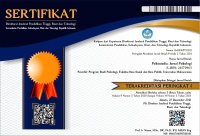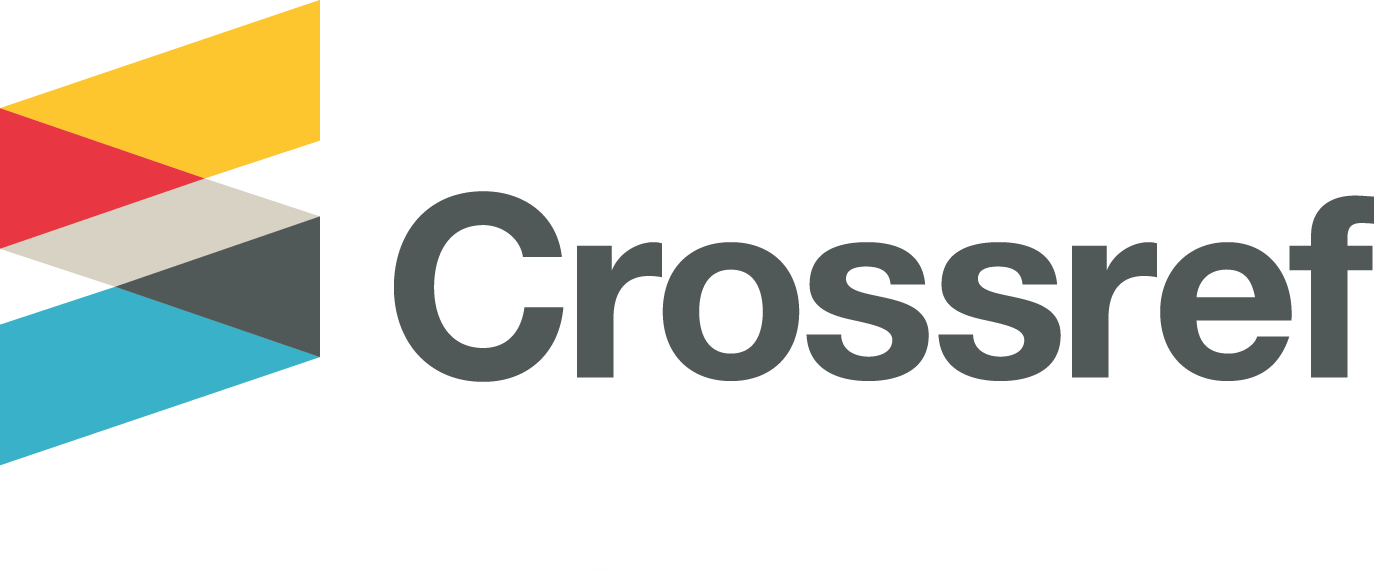Sensory Science Project Learning Methods for Student Readiness to Enter Elementary School
Abstract
Researchers designed the sensory science project (SSP) learning model according to the cognitive and psychological development of early childhood. SSP contains sensory stimulation activities and knowledge material which are arranged in an integrated manner in an activity project. This research aims to determine the effect of the SSP learning method on students' readiness to enter elementary school.This research method is quantitative research analysis with a quasi experiment approach. This research design uses a nonequivalent comparison group, conducting a pre-test and post-test on the control group and experimental group at the same time (Creswell, 2016). The data collected used the Nijmeegse schoolbekwaamheids Test (NST) and subject observation. The learning intervention used uses the sensory science project (SSP) module which has gone through a module testing process. The research subjects were 24 children, aged 5-6 years who were attending early childhood education at TK B level at TK RJ Sidoarjo. The results of this research found that there was an influence of implementing the SSP model on children's readiness to enter elementary school. The independent sample t-test produced a value of t(19)=2.392, p=0.027. The average posttest score for the experimental group was 55.70, while for the control group it was 46.73. The average posttest score for the experimental group was higher than the control group. This proves that there was a greater increase in scores for the experimental group after being given the SSP learning intervention. The results of this research can be used as input and consideration in designing educational methods for early childhood which include inquiry learning, sensory integration and project based learning. It is hoped that this method can support children's school readiness to enter elementary school.
Peneliti merancang model pembelajaran sensory science project (SSP) sesuai dengan perkembangan kognitif dan psikologis anak usia dini. SSP berisi kegiatan stimulasi sensori dan materi pengetahuan yang disusun secara terintegrasi dalam sebuah proyek kegiatan. Penelitian ini bertujuan untuk mengetahui pengaruh metode pembelajaran SSP terhadap kesiapan siswa memasuki SD. Metode penelitian ini adalah analisis penelitian kuantitatif dengan pendekatan quasi experiment. Desain penelitian ini menggunakan nonequivalent comparasion group, melakukan pre test dan post test kepada kelompok kontrol dan kelompok eksperimen di waktu yang bersamaan (Creswell, 2016). Penggalian data yang digunakan menggunakan Nijmeegse Schoolbekwaamheids Test (NST) dan observasi subyek. Intervensi pembelajaran yang digunakan menggunakan modul sensory science project (SSP) yang telah melalui proses uji coba modul. Subyek penelitian berjumlah 24 anak, usia 5-6 tahun yang sedang mengikuti pendidikan usia dini jenjang TK B di TK RJ Sidoarjo. Hasil penelitian ini menemukan adanya pengaruh penerapan model SSP terhadap kesiapan anak masuk SD. Uji independent sample t-test menghasilkan nilai t( 19)=2,392, p=0,027. Nilai rata-rata posttest untuk kelompok eksperimen adalah 55,70, sedangkan pada kelompok kontrol adalah 46,73. Rata-rata nilai posttest kelompok eksperimen lebih tinggi daripada kelompok kontrol. Hal ini membuktikan bahwa ada peningkatan nilai lebih besar terhadap kelompok eksperimen setelah diberi intervensi pembelajaran SSP. Hasil penelitian ini dapat digunakan sebagai bahan masukan dan bahan pertimbangan dalam merancang metode pendidikan untuk anak usia dini yang mencakup pembelajaran inquiry, sensori integrasi dan project based learning. Diharapkan metode tersebut dapat mendukung kesiapan sekolah anak untuk memasuki sekolah dasar.
Keywords
Full Text:
FULL TEXTReferences
Affandi, G. R., & Mariyati, L. I. (2018). Uji validitas bender-gestalt test dengan menggunakan nijmeegse schoolbekwaamheids test (nst) sebagai kriteria untuk mendeteksi kesiapan anak masuk sekolah dasar. INSAN Jurnal Psikologi dan Kesehatan Mental, 2(2), 84. https://doi.org/10.20473/jpkm.v2i22017.84-95
Alwi, I. (2015). Kriteria empirik dalam menentukan ukuran sampel pada pengujian hipotesis statistika dan analisis butir. Formatif: Jurnal Ilmiah Pendidikan MIPA, 2(2): 140-148
An, X., Curby, T. W., & Xie, Q. (2018). Chinese teachers’ perceptions of early childhood school readiness. School Psychology International, 39(5), 454–469. https://doi.org/10.1177/0143034318790635
Barrow, L. H. (2006). A brief history of inquiry: From dewey to standards. In Journal of Science Teacher Education (Vol. 17, Issue 3, pp. 265–278). https://doi.org/10.1007/s10972-006-9008-5
Bušljeta, R. (2013). Effective Use of Teaching and Learning Resources. Czech-Polish Historical and Pedagogical Journal, 5(2). https://doi.org/10.2478/cphpj-2013-0014
Christensen, D., Taylor, C. L., Hancock, K. J., & Zubrick, S. R. (2022). School readiness is more than the child: a latent class analysis of child, family, school and community aspects of school readiness. Australian Journal of Social Issues, 57(1), 125–143. https://doi.org/10.1002/ajs4.138
Connell, C. M., & Prinz, R. J. (2002). The Impact of Childcare and Parent-Child Interactions on School Readiness and Social Skills Development for Low-Income African American Children.
Creswell, J. W. (2016). Research Design : Pendekatan Kualitatif, Kuantitatif, dan Mixed (keempat). Pustaka Pelajar.
Damayanti, A. K., & Psikologi, R. F. (2019). Kesiapan anak masuk sekolah dasar ditinjau dari tingkat inteligensi dan jenis kelamin. Psikovidya, 23(1).
Nelly, N. (2016). Efektivitas jam belajar mengajar matematika dan bahasa bagi murid paud. Bunayya: Jurnal Pendidikan Anak, 1(2), 66-83.
Indarta, Y., Jalinus, N., Waskito, W., Samala, A. D., Riyanda, A. R., & Adi, N. H. (2022). Relevansi Kurikulum Merdeka Belajar dengan Model Pembelajaran Abad 21 dalam Perkembangan Era Society 5.0. EDUKATIF : Jurnal Ilmu Pendidikan, 4(2), 3011–3024. https://doi.org/10.31004/edukatif.v4i2.2589
Johnson, L., McHugh, S., Eagle, J. L., & Spires, H. A. (2019). Project-Based Inquiry (PBI) Global in Kindergarten Classroom: Inquiring About the World. Early Childhood Education Journal, 47(5), 607–613. https://doi.org/10.1007/s10643-019-00946-4
Larson, L. C., & Miller, T. N. (2011). 21st Century Skills: Prepare Students for the Future. Kappa Delta Pi Record, 47(3), 121–123. https://doi.org/10.1080/00228958.2011.10516575
Halimah, N., & Kawuryan, F. (2010). Kesiapan memasuki sekolah dasar pada anak yang mengikuti pendidikan tk dengan yang tidak mengikuti pendidikan tk di kabupaten kudus. Jurnal Psikologi Universitas Muria Kudus: Vol. I (Issue 1).
Hijriati. (2017). Pengembangan model pembelajaran pendidikan anak usia dini. Bunayya: Jurnal Pendidikan Anak,( Vol 3, No 1)
Paramita, S., Soetikno, N., & Irena, F. (2019). Studi kasus pada anak dengan regulatory sensory processing disorder di klinik tumbuh kembang x. Jurnal Muara Ilmu Sosial, Humaniora, Dan Seni, 3(2), 367. https://doi.org/10.24912/jmishumsen.v3i2.3873
Piether, A. E., Rinjani, O. A., & Iskandar, B. P. (2016). Keajaiban 7 Indra : Optimalkan Tumbuh Kembang Anak Melalui Permainan Sensori (pertama). Rumah Dandelion .
Pradini, S., Harkina, P., & Sandayanti, V. (2020). Profil kesiapan masuk sekolah dasar usia 5-6 tahun di bandar lampung. Jurnal Pendidikan Anak, 6(1), 52-59. (Vol. 6, Issue 1).
Rafidiyah, D., & Normulati, S. (2020). Obstacles and Solution of Beyond Centers and Circle Time (BCCT) Implementation. Indonesian Journal of Early Childhood Education Studies, 9(1), 13–18. https://doi.org/10.15294/ijeces.v9i1.38559
Rahmawati, A., Maritje, M., Tairas, W., Ainy, N., & Nawangsari, F. (2018). Profil kesiapan sekolah anak memasuki sekolah dasar. https://doi.org/10.21009/JPUD.122
Saifuddin, A. (2019). Penelitian eksperimen dalam psikologi. . Kencana Prenada Media.
Sanjaya, W. (2011). Strategi Pembelajaran Berorientasi Standar Proses Pendidikan. Kencana Prenada Media.
Schaaf, R. C. , & N. K. M. (2007). Occupational Therapy Using a Sensory Integrative Approach: A Case Study of Effectiveness. The American Journal of Occupational Therapy, Vol. 61(2), 239–246.
Viranda, dkk. (2019). Bermain peran (role play) dan peningkatan keterampilan sosial anak usia dini. Psikostudia: Jurnal Psikologi, 8(June 2019), 1–6.
Waiman, E. , S. S., Gunardi, H. , S. R., & & Endyarni, B. (2011). Sensori integrasi: dasar dan efektivitas terapi. Sari Pediatri.
DOI: http://dx.doi.org/10.30872/psikostudia.v13i1.13119
Refbacks
- There are currently no refbacks.
Copyright (c) 2024 Ratna Prayudiptya Azarine, Nur Ainy Fardana, & Dewi Retno Suminar

This work is licensed under a Creative Commons Attribution-ShareAlike 4.0 International License.
Psikostudia: Jurnal Psikologi is indexed by :
PSIKOSTUDIA: Jurnal Psikologi Published by Faculty of Social and Political Siences, University of Mulawarman, Samarinda, East Kalimantan and This work is licensed under a Creative Commons Attribution-ShareAlike 4.0 International License.
_________________________________________
PSIKOSTUDIA: Jurnal Psikologi
Department of Psychology
Faculty of Social and Political Siences, University of Mulawarman
Jl. Muara Muntai Kampus Gn. Kelua Samarinda 75411
Phone: +62 813 35350368
E-Mail: psikostudia@fisip.unmul.ac.id




















